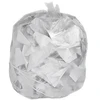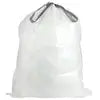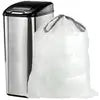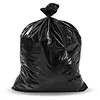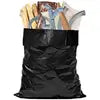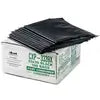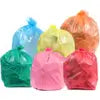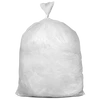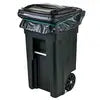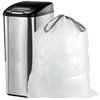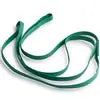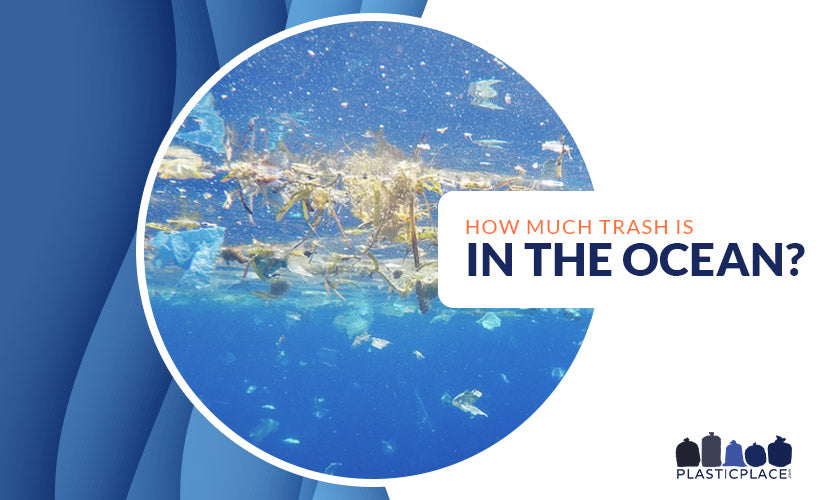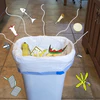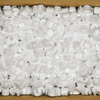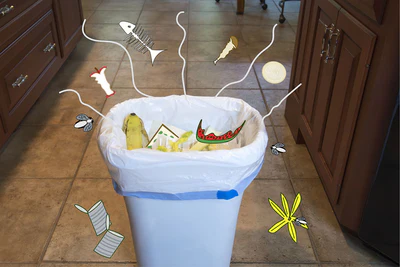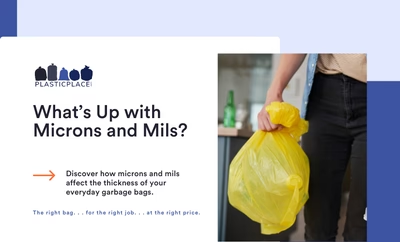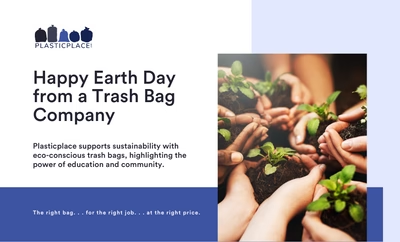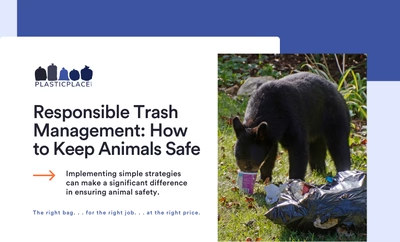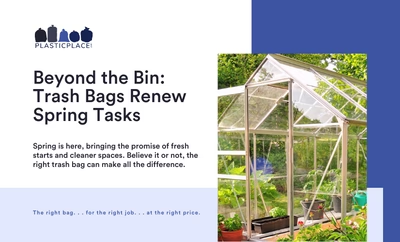The amount of trash in the ocean can feel as unmanageable as every other environmental crisis. Eco-anxiety is at an all-time high. And the accompanying angst can make the numbers feel not just unreal, but unconquerable.
So, while the amount of trash in the ocean and the resulting problems feel as huge as the ocean itself, remind yourself to focus on the right questions. It’s important to know how much trash is in the ocean. But it’s more important to know what’s being done about it. And what’s even more important than that? Knowing what you can do about it.
Get Your Eco-Friendly Garbage Bags Here
Ocean Trash: It’s a Lot
Much of the trash in the ocean is made up of over five trillion pieces of plastic. Of that, more than 250,000 tons of garbage float on the ocean’s surface. But there is far more garbage under the surface. Over time, that ocean plastic degrades in the sun and salt water to form smaller plastic particles. These microplastics are about the size of a grain of rice or smaller. And there are about four billion of them in every square kilometer of the ocean.
Abandoned fishing nets also litter the ocean. According to one study, over 700,000 tons of fishing nets are discarded in the ocean every year.
Much of the garbage in the ocean collects where currents meet. There are actually five large garbage patches in the ocean.
The Great Pacific Garbage Patch is the largest collection of trash in the ocean and is double the size of Texas. And it’s a few meters deep. According to Ocean Cleanup, the Great Pacific Garbage Patch contains 1.8 trillion pieces of plastic and weighs 80,000 tons.

Why Is So Much Ocean Trash Plastic?
We’re using far more plastic than we used to, and much of that plastic is not environmentally friendly. In the last 10 years, we’ve used more plastic than we did during the entire 20th century. And about half of the plastic we use is designed to be used once, then thrown away. From disposable water bottles to coffee cups to plastic wrap on the products we buy, there is simply too much.
Plastic’s physical properties help carry it, literally, to the oceans. Small and lightweight, plastic wrappers, straws and empty water bottles are easily blown while in transport and carried to waterways. Once there, plastic breaks down much more slowly than other types of trash. Plastic crates manufactured in 1970 have recently been found in the ocean.
Get Your 30-Gallon Compostable Trash Bags Here
Where Does All That Trash Come From?
When it comes to a problem as vast as the oceans themselves, it isn’t surprising that trash in the ocean comes from many places.
United States
For years, researchers thought the U.S. was practically blameless for the trash in the ocean. Considering our efficient and widespread waste management system, it was thought that the only way plastic used in the U.S. ended up in the ocean was through littering.
Our optimistic view of our role in the ocean trash was despite the fact that the U.S. is the largest producer and consumer of plastics. The average American uses 289 pounds of plastic each year. And we recycle a very small portion of our plastic.
A new study takes into account a more nuanced picture of U.S. waste management. Researchers factored in illegal dumping, which still occurs. And they also factored in the trash we export to other countries. These poorer countries lack the infrastructure to properly manage U.S. recycling and trash. As a result, a significant portion of our trash imports ends up in the ocean. In fact, the new study estimates that the U.S. is the third-worst polluter of the ocean.

Every coastal area in the U.S. can be a springboard for ocean trash, even near the Great Lakes. When garbage is transported, the light plastic pieces, like empty water bottles, can blow away and eventually make their way to the ocean. That’s why it’s so important to use large, black trash bags that are both strong and environmentally friendly.
All of this led one researcher to say, “The United States is a leader in causing the plastic pollution crisis in the world.”
Shop for Large Black Trash Bags
Sanitation Processes in Poor Countries
About 60 percent of the plastic enters the oceans from five countries, all of them in Asia. In these countries, over half of the garbage generated is not properly collected. Instead, communities create large, open trash piles where wind and rain wash the lighter items, usually plastic, to waterways. In some of these countries, sanitation facilities are built near coastlines where trash easily ends up in the ocean.
Boats and Fishermen
Roughly 20 percent of the trash comes from cargo ships and boaters. Some of this trash, fishing nets, gets lost during bad weather, such as storms. Sometimes, boaters simply toss their trash into the ocean.
Laundry Runoff
Your sweatshirt may have a much different texture than your water bottle. Still, the synthetic fibers in our clothing are made of plastic. Washing our clothes sends microplastics into the water system, where they make their way to the ocean. Experts estimate about 35 percent of microplastics in the environment come from laundry.
Microbeads in Personal Care Products
Microbeads of plastics are used in a variety of skincare products to influence their texture. These microbeads can make the product silky smooth or coarse. Facial scrubs commonly use microbeads to achieve their consistency.
How Ocean Trash Harms Animals
All of that ocean garbage has devastating effects on marine life. About 100 million animals die annually due to plastic in the ocean.

Discarded Fishing Nets
Discarded fishing nets, many of which are two miles long, continue to kill animals long after the fishermen have gone home. Discarded fishing nets can kill marine animals that get caught in them. One report found that 45 percent of threatened marine mammals have been harmed by discarded fishing nets. Even whales can get caught in nets. Once a whale is caught, the net becomes an increasing burden as it collects more debris.
Sea Turtles
Researchers estimate that about half of the world’s sea turtles have eaten plastic. Plastic bags floating in the ocean tend to look like jellyfish to sea turtles. And just one piece of plastic could kill them. Fishing nets tend to accumulate in areas where sea turtles nest, putting them at risk of entanglement.
Sea Birds
At the beginning of the 21st century, researchers found microplastics in about 15 percent of fish. By 2010, the amount of fish containing microplastics rose to 33 percent. Marine fish is the primary diet of seabirds, whose populations have been steadily declining. Seabirds also mistake microplastics for food. One study projects that 99 percent of seabirds will be affected by plastic ingestion by 2050. Currently, a third of seabird species are globally threatened.
Implications on Humans
The microplastics in the ocean are finding their way into our food. There is a 30 percent chance that the tuna or salmon in your sushi contains microplastics. One study of canned fish found plastic particles in 80 percent of the samples.
A recent study found plastic in human blood for the first time. Though the sample was small, 77 percent of the study’s participants had blood samples contaminated with microplastics. It was the first time researchers could prove what we’ve all suspected: plastic is in our bodies.

No one knows how microplastics are affecting us. But we do know that plastic, in general, has damaging effects on our health. The chemicals in plastics have been linked to cancer, autism and infertility. The plastic in water bottles has been shown to cause diabetes, obesity and the early onset of puberty.
When plastic breaks down in the ocean it releases toxic chemicals known to be harmful to people. The chemicals include mercury and lead and are very harmful to developing babies.
Global Efforts to Clean the Oceans
Cleaning the oceans requires more than removing the five trillion pieces of garbage that are currently floating in the waters. From its production to its use to its disposal, we must fundamentally change the way we use and manage plastic. There are dozens of organizations working to do just that.
Many organizations are focusing on cleaning beaches and communities near waterways. Take 3 encourages people to pick up three pieces of garbage every time they go to the beach. They claim their initiative removes 10 million pieces of garbage annually. Even more importantly, Take 3 focuses on educating people about ocean garbage.
The Ocean Cleanup uses technology with the goal of cleaning up 90 percent of floating ocean plastic by 2040. The relatively new organization collected 500,000 pounds of ocean plastic in 2020. Ocean Cleanup seeks to create a market for upcycled ocean plastic.
In addition to educating citizens and lobbying for improved laws, Clean Ocean Action works to clean the eastern U.S. coast. Clean Ocean Action sponsors Beach Sweeps, during which 10,000 volunteers pick up half a million pieces of trash in just a few hours. The organization is also working to create the nation’s first Clean Ocean Zone, an area of coastline off-limits to industrial activities.
Currently, the United Nations is drafting a UN plastic treaty designed to sharply curb plastic waste. The treaty is supported by more than three-quarters of UN members, including the United States. The treaty will be ready for signing in 2024.
Potential Technologies to Clean Oceans
The discarded fishing nets in the ocean are primarily there because fishermen lost them in bad weather. And they’re almost as unhappy about their loss as the marine animals. Fishing gear, like those nets, costs thousands of dollars. Some manufacturers are tagging these fishing nets with GPS devices to help make them easier to locate. Other manufacturers are developing biodegradable fishing nets that will dissolve over time.
Ocean Cleanup created System 001 as a prototype for large-scale ocean cleanup. System 001 is a 2,000-foot device designed to collect ocean plastic without harming wildlife. During its first launch, System 001 cleaned about 80,000 tons of garbage from the Great Pacific Garbage Patch. Ocean Cleanup’s goal is to use the System 001 technology to clean 50 percent of the ocean’s trash in five years.
While Ocean Cleanup focuses on the oceans, Mr. Trash Wheel targets ocean trash where it begins: in rivers and harbors. With four devices stationed around Baltimore, MD, Mr. Trash Wheel has collected over 2,000 tons of waterway trash destined for the ocean.

What You Can Do
Now, we’re on to the most important question: what can you do to reduce the trash in the ocean? You can do more than you think.
Reduce Single-Use Plastics
While recycling is essential, we cannot recycle our way out of our plastics problem. Use a reusable water bottle and start remembering your reusable grocery bags. Always say no to plastic straws. And when you do use plastic, make the most environmentally sound choice.
Clean Up Your Local Waterways
Regardless of where litter is, it will almost always follow the same path as rainwater and end up in waterways. You can help by making a habit of picking up the trash you see on the sidewalk. You can also participate in community beach cleanups. If there isn’t one already in your area, you organize your own cleanup.
Reduce Microfibers in Your Laundry
Install a filter on your machine. A filter installed on your washing machine can reduce almost 90 percent of the microfibers entering your drain system.
Wash Your Clothes in Full Loads. One study found that washing clothes in full loads reduces friction and cuts the amount of escaping microplastics by half.
Avoid Microbeads
Microbeads are increasingly showing up in our personal care products. You can find out if your favorite products contain microbeads by searching this website.
Don’t let your eco-anxiety get the better of you. Sure, ocean trash is a big problem. But there are people and organizations working to solve errant plastic trash and clean up the ocean. Additionally, increasing awareness and public pressure are leading to breakthrough government action like the UN Plastics Treaty.
And most importantly, each of us can take responsibility for our trash and take steps to avoid it ending up in the ocean. Reduce the amount of single-use plastic you use. And when you do use plastic, always opt for environmentally responsible choices. At Plasticplace.com, our Earth Friendly Policy ensures you’re making the most environmentally responsible choice for your plastic bags.
Image Credits
Pintau Studio/Shutterstock.com
Alex Popov/Shutterstock.com
Rich Carey/Shutterstock.com
Richard Whitcombe/Shutterstock.com
olenalavrova/Shutterstock.com
Inside Creative House/Shutterstock.com
Aleksandra Bataeva/Shutterstock.com
 4.9 out of 5
4.9 out of 5  Mix and Match: Buy any two products for 10% off!
Mix and Match: Buy any two products for 10% off!












